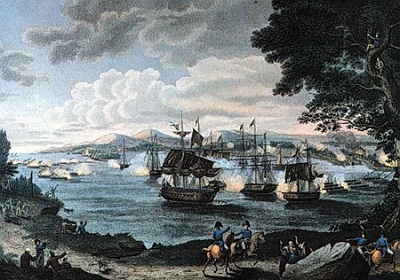The American victory on Lake Champlain in 1814 was a decisive moment, saving the United States from British conquest and weakening British claims for territorial concessions during the peace talks at Ghent.
“The firing was terrific, fairly shaking the ground, and so rapid that it seemed to be one continuous roar, intermingled with the spiteful flashing from the mouths of guns, and dense clouds of smoke soon hung over the two fleets.” J. C. Hubbell, a civilian witness to the battle.

Engraving by B. Tanner, 1816. Public Domain.
Many Americans viewed the War of 1812 as a “Second American Revolution,” a struggle between their young nation and Great Britain. But events far away exerted enormous influence on the course of the conflict in North America. In 1813, developments in the long-standing struggle between France and Great Britain rippled all the way across the Atlantic, affecting the fighting during the war’s second year.
In Europe, Napoleon’s bloody defeat at the Battle of Leipzig in October 1813 proved a decisive turning point in the long and costly Napoleonic Wars. Within just a few short months, the Allies would occupy Paris, exiling Napoleon from his throne. Finally, it seemed, Europe might have peace.
But the implications of Napoleon’s defeat were not limited to Europe. Shifting fortunes across the Atlantic meant that thousands of battle-hardened British regulars would be freed up to fight in North America. With the 1814 campaign season set to begin, and thousands of experienced redcoats soon to arrive on Canadian shores, American military commanders must have felt a sense of foreboding.
Lake Champlain in upstate New York would serve as the staging point for the renewed British invasion of the United States. Sir George Prevost, the governor general of Canada, intended to march his 10,000 British troops southward through Plattsburgh to Albany, effectively isolating New England from the rest of the country. British Naval forces would support Prevost’s infantry by controlling the lake and pressuring Plattsburgh from its harbor side.
The American forces at Plattsburgh were severely undermanned, and a single American naval squadron patrolled the lake. With much riding on the invasion, the British had assembled a formidable force on land and sea. And the campaign’s initial developments were encouraging for the British: on September 11, 1814, with land forces prepared to assault Plattsburgh, British sailors inflicted what appeared to be crippling damage to the American flagship, leaving it unable to fire from the side facing the enemy vessel—a disastrous consequence for any warship in battle.
But in an astonishing maneuver, the American crew used cables to bring their ship around, presenting a new, undamaged broadside against the British flagship. The ensuing American attack was devastating, and the crippled British vessel surrendered along with the remainder of the British squadron.
British sailors would later remark that Lord Nelson’s victory against the French and Spanish at Trafalgar was a “mere flea bite” compared to this furious naval action at Lake Champlain. Sir Prevost, believing that his land invasion would falter without control of Lake Champlain, began a retreat north.
Fought with a razor-thin margin, the American victory on Lake Champlain was one of the most decisive moments of the war. It saved the Americans from conquest, and in the process substantially weakened British claims for territorial concessions during the Ghent peace talks.
Last updated: May 24, 2016
